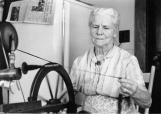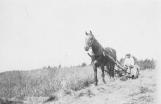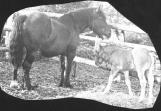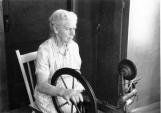1
Farming On the IslandsLong and Brier Islands provided far from ideal conditions, either in weather or soil,for productive farms. However, to be self-sufficient, the people developed a farming sector. Most of the farming consisted of the individual family keeping a pig, a cow and some chickens, and growing their own vegetables. There were a few devoted and industrious farm families, with larger farms being located at Gull Rock, Brier Island, the Pyne family farm in Freeport,Small's in Central Grove, as well as the Pughs in Westport and the Melansons in Freeport.
There were a small number of specialists - dairy farmers, fox farms and a mink farm. Typical of the few general farms was that of the Small family in Central Grove. When we look at their records, we see that their most popular vegetable was turnip. Most of us remember just how staple this vegetable was in the winter, and especially in the early spring.
The variety of products this family handled is quite astounding. The list of items in their annual accounts included the following:
- vegetables: potatoes, turnips, carrots, squash, beets,parsnips,cabbage,corn,cucumbers,
pumpkins
- meat: lamb, pork, beef, chicken
-eggs
-fruit: apples, quinces, berries ( strawberries, blueberries, cranberries)
-forest products: logs in bulk, firewood, sawed wood, axe handles, along with some bulk logs for wharves and other construction
-other: lamb pelts, yarn, mittens, socks, butter, straw, hay, flowers
Imagine the work involved in looking after all those animals and producing quantities of these items. Expenses on the farm would include feed, fuel for machinery, hired men, tools, and some food stuffs such as flour, sugar,molasses, yeast etc.
Most of the accounts with the farm customers were paid by cash, but there were also lists of labour done in payment for food, such as butchering, sawing wood, shoeing oxen etc.
Let's look at just a few comparative prices of the products over their busy years.
Item: 1929 1941 1946-48
Potatoes, bushel 1.00 1.00 1.40
Carrots 1.00 1.00 2.00
Turnips .50 .50 .75
Beef/pound .50 .50-75 1.00
Lamb .50 .20 .75
Pork .15 .30 - .37
Eggs per dozen .30 .40 .50
Squash/100 lb. 3.00 2.00 3.00
Apples/barrel 3.25 5.25
Berries/quart .20 .20 .25
Quinces/doz .50 .80
Logs/foot .08 .08 Wood/cord 7.00 7.00
Labour/day 1.00 1.00 .60 -.80
Prices charged had remained almost constant from the 20's to the war years, and in a few cases even dropping a little during the war. Directly after the war there was a sudden and substantial increase,along with a drop in the amount paid for labour.
The farm required year round work and all members of the family had to pitch in. The islands people raised large families in harsh circumstances and struggled to keep them fed and clothed. The Small family women, as well as others of Long and Brier Islands were adept in the arts of spinning, weaving, knitting, sewing as well as rug hooking.
They were not specialists - a fisherman's family had their own garden and animals, canned products of farm and nature, and had informal contests to see who could raise the fattest pig or the biggest turnip.
Even the social notes in a local paper could be depended upon to give information about what was happening in the farmyard.
- Mr. L.C. Bailey has grown a number of parsnips that girt 15 inches. Beat this if you can.
- Mr. J.A. Peters has a very fine cow. From July 3rd to August 1st he made 61 pounds of butter.
Another farmer was noted for his dahlias.
Were these hard working, struggling ancestors of ours perhaps more content and accepting of their lot than we are with all our luxuries? These people were creative, versatile, clever , and self reliant. We can be proud of them.
3
Raymond: We farmed on Gull Rock Farm, I lived on Gull Rock Farm when I was just a kid.Brenda: When your father worked on Gull Rock Farm, did they have sheep or what animals did they have?
Raymond: No, they had milking cows, we had 24 milking cows down there. And we separated all the milk and shipped the cream to the Yarmouth Ice Cream and Dairy Company by boat from here, twice a week.
Brenda: On the Keith Cann?
Raymond: On the old Keith Cann.
Brenda: When you were a boy at home, did you grow and raise your own vegetables?
Raymond: When my Dad worked on Gull Rock Farm, he grew vegetables down there and he had an old white horse and a wagon and he use to peddle them around town, 10 cents a bunch for carrots, and 10 cents a bunch for beets and things like that. And he grew potatoes and sold them and one thing another. Along with the rest of the work down there.
Brenda: Did you have animals, did you raise any animals for eating?
Raymond: He had 24 milking cows, and he had a lot of young cattle that use to graze around the big pond down there and of course, every fall he'd kill those and he had pigs and hens and things like that. A big white horse, I can remember.I can remember Dad trying to make money. We had an old Essex car, and he cut it off and made a little truck out of it. And I can remember him buying 500 lbs of great big bull haddock, nice great big haddock, and he cleaned them all up, salted them and put them in the smoke house and smoked them, and he paid .40 cents a hundred weight for those haddock. $2.00 for 500 lbs. And he smoked them all up and I went with him in the truck all the way up the valley to sell them and he sold them for .50 cents a piece. And the farmers didn't have any money, so they'd say, I'd like to have one, but I haven't got any money but I've got lots of apples and lots of turnips and lots of potatoes. And we'd come back with no money a whole load of groceries, a whole load of vegetables. And I remember stopping at Tupper Warren's in Digby. In the saw mill there, and we had quite a few left, about 100 lbs., and we weighed them up and went up to see Mr. Warren and he said oh yes, I'll take those and what I can't sell I'll take and sell in the woods for the men in the woods. So we unloaded them and we waited and waited and nobody said anything about pay. So at last I said, Dad, it's getting dark, we'd better get back home. And he went upstair and he said to Mr. Warren, I'd like to have my money for my fish. And Mr. Warren says, oh, some misunderstanding here. No money, no money. All kinds of groceries downstair, you just help yourself. Went downstairs and Dad grabbed a bag of sugar and a bag of flour and away we went for Westport and away we went. But he didn't come back with no money.
6
Melzena Small is shown with one of the work horses on her family farm.1940
Central Grove, Nova Scotia, Canada

9
William Pugh, in front of his fish shop, with one of his herd of sheep1920
Westport, Nova Scotia, Canada
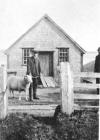
10
Sheep were excellent animals to have on Long and Brier Islands. They managed to live well by grazing on the somewhat rocky pasture land thatexists here. In addition to supplying meat, their wool provided raw materials for clothing and bedding, as well as yarn for fishermen's mittens and necessary sweaters. The sheep were sheared, the wool was picked and cleaned, carded and then spun. The wool yarn was then woven into blankets or used for knitting.
11
Melzena Small with a lamb from their farm. Their chicken coop is seen in the background.1940
Central Grove, Nova Scotia, Canada
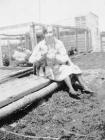
14
Josie (Josephine) Delaney Small at her spinning wheel, spinning wool1960
Mochelle, Nova Scotia, Canada
